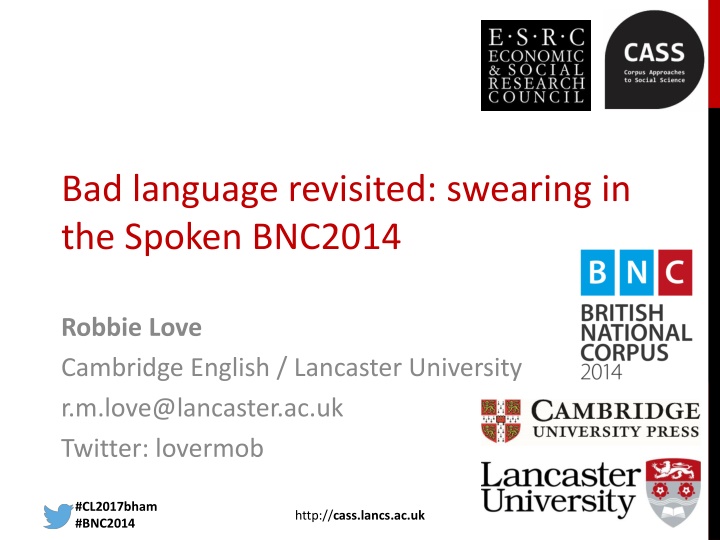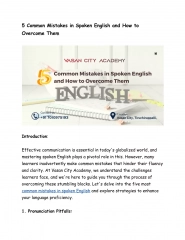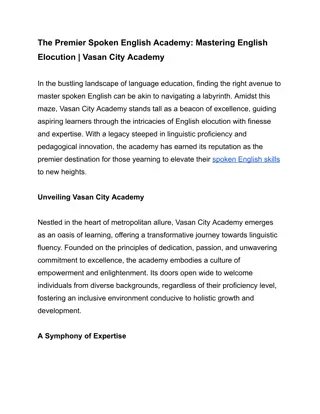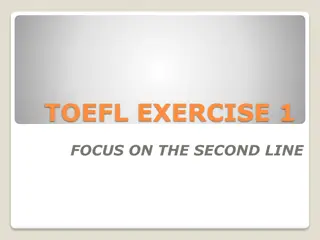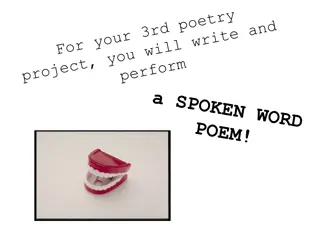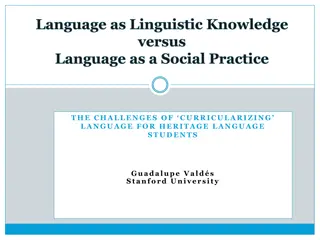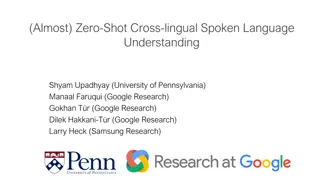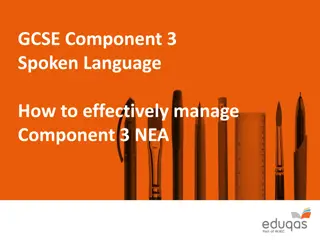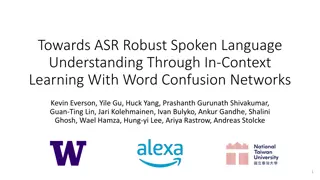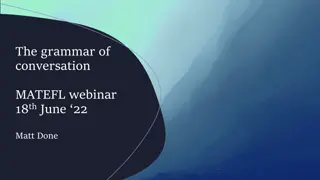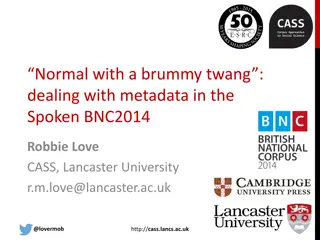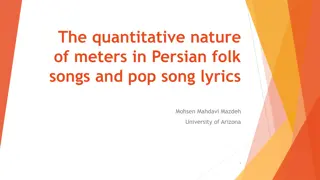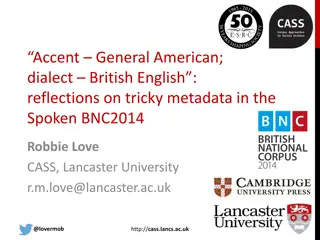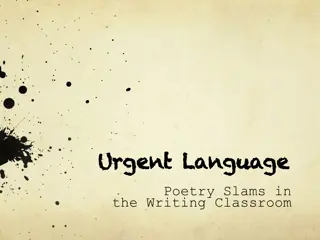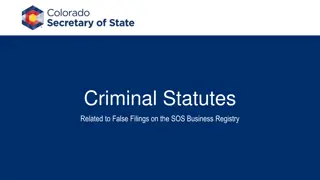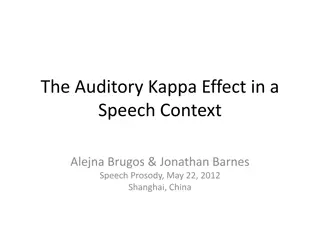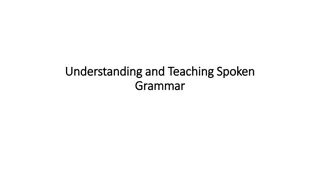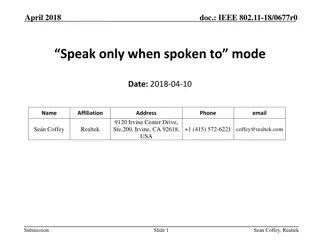Swearing in the Spoken BNC2014: A Detailed Study
This research delves into the use of bad language in the Spoken BNC2014 data by Robbie Love from Lancaster University and explores the reasons behind such language usage. The study covers research questions, data collection methods, findings, conclusions, and limitations. It also examines speaker and text metadata, the team behind the Spoken BNC2014 project, and provides information on the compilation details. The research includes details on the corpus, user guide, and Love's PhD thesis.
Download Presentation

Please find below an Image/Link to download the presentation.
The content on the website is provided AS IS for your information and personal use only. It may not be sold, licensed, or shared on other websites without obtaining consent from the author.If you encounter any issues during the download, it is possible that the publisher has removed the file from their server.
You are allowed to download the files provided on this website for personal or commercial use, subject to the condition that they are used lawfully. All files are the property of their respective owners.
The content on the website is provided AS IS for your information and personal use only. It may not be sold, licensed, or shared on other websites without obtaining consent from the author.
E N D
Presentation Transcript
Bad language revisited: swearing in the Spoken BNC2014 Robbie Love Cambridge English / Lancaster University r.m.love@lancaster.ac.uk Twitter: lovermob #CL2017bham #BNC2014 http://cass.lancs.ac.uk
Todays talk 1. The Spoken BNC2014 2. Bad language why? 3. RQs 4. Data & methods 5. Findings 6. Conclusions & limitations #CL2017bham #BNC2014 http://cass.lancs.ac.uk 2
The Spoken BNC2014 SPOKEN #CL2017bham #BNC2014 3
The Spoken BNC2014 Conversational, L1 British English Mostly English English see Love et al. (in press) 2012-2016 672 speakers 1,251 texts 11,422,622 words To be freely available (1) on CQPweb, then (2) file download #CL2017bham #BNC2014 4
Speaker metadata Age (1994 & new groups) Dialect Highest qualification Gender Socio-economic status (1994 & new groups) Selected for socioling. balanced core? #CL2017bham #BNC2014 5
Text metadata Selected for Sample release? No. of speakers Year of recording Quarter of recording (e.g. 2016 Q1) Transcriber #CL2017bham #BNC2014 6
Who built the Spoken BNC2014? Lancaster University: Robbie Love, Andrew Hardie, Vaclav Brezina, Tony McEnery Cambridge University Press: Claire Dembry Olivia Goodman, Imogen Dickens, Sarah Grieves, Laura Grimes, Samantha Owen, 20 transcribers #CL2017bham #BNC2014 http://cass.lancs.ac.uk 7
For more info on compilation See: Love, Dembry, Hardie, Brezina & McEnery (2017 in press) corpus citation paper Love & Hardie (2017 forthcoming) user guide Love (forthcoming) entire PhD thesis #CL2017bham #BNC2014 http://cass.lancs.ac.uk 8
Love PhD thesis Literature review & rationale Design, recruitment, metadata & audio data Transcription XML conversion & annotation Methodological investigation: speaker identification Demo the corpus: bad language! #CL2017bham #BNC2014 http://cass.lancs.ac.uk 9
Bad language #CL2017bham #BNC2014 10
Bad language Swearing is fascinating a marker of distinction between social groups (McEnery 2005: 24) a rich emotional, psychological, and sociocultural phenomenon (Jay 2009: 153) More psychologically arousing (Janschewitz 2008) More memorable (Jay et al. 2008) More stressful to produce (Bowers & Pleydell-Pearce 2011) #CL2017bham #BNC2014 11
Bad language People care about it one way or another e.g. links to anti-social behaviour #CL2017bham #BNC2014 12
Bad language McEnery (2005): Bad language words = BLWs swear words, always taboo cunt, fuck, shit, twat words which are not inherently taboo but can be used to offend tart, pig, god, gay #CL2017bham #BNC2014 13
Bad language revisited Replication of McEnery (2005) on the new data Over 150 BLWs, drawn from: McEnery (2005) ARSE, ARSEHOLE, BALLS, BASTARD, BIRD, BITCH, BLOODY, BOLLOCKS, BUGGER, CHRIST, COW, CRAP, CUNT, DAMN, DICKHEAD, FUCK, GAY, GIT, GOD, HELL, HUSSY, IDIOT, JESUS, JEW, MORON, MOTHERFUCKER, NIGGER, PAKI, PIG, PILLOCK, PISS, PISSED OFF, POOFTER, PRICK, SCREW, SHAG, SHIT, SLAG, SLUT, SOD, SON-OF-A-BITCH, SPASTIC, TART, TIT, TITS, TOSSER, TWAT, WANKER, WHORE Ofcom (2016) BATTY BOY, BEAVER, BEEF CURTAINS, BELLEND, BENDER, BINT, BLOODCLAAT, BONK, BUKKAKE, BULLSHIT, BUM BOY, BUMCLAT, BUMMER, CHI-CHI MAN, CHICK WITH A DICK, CHINKY, CHOC ICE, CLUNGE, COCK, COCKSUCKER, COFFIN DODGER, COLOURED, COON, CRETIN, CRIPPLE, DAGO, DARKY, DICK, DILDO, DIV, DYKE, FAGGOT, FAIRY, FANNY, FECK/EFFING, FENIAN, FLAPS, FOP (FUCKING OLD PERSON) , FUDGE-PACKER, GASH, GENDER BENDER, GINGER, GIPPO, GODDAM, GOLLIWOG, GOOK, HE-SHE, HO, HOMO, HONKY, HUN, JAP, JESUS CHRIST, JIZZ, JOCK, KAFIR/KUFAAR, KIKE*, KNOB, KRAUT, LEZZA/LESBO, LOONY, MENTAL, MIDGET, MINGE, MINGER, MONG, MUFF DIVER, MUNTER, NANCY, NAZI, NEGRO, NIG-NOG, NONCE, NUTTER, OLD BAG, PANSY, PAPIST, PIKEY, PISSED / PISSED OFF, POLACK, POOF, PRICKTEASER, PROD, PSYCHO, PUNANI, PUSSY, QUEER, RAGHEAD, RAPEY, RETARD, RUGMUNCHER/ CARPETMUNCHER, SAMBO, SCHIZO, SHIRT LIFTER, SKANK, SLAPPER, SLOPE, SNATCH, SOD-OFF, SON OF A BITCH, SPADE, SPASTIC/SPAKKA/SPAZ, SPECIAL, SPIC, TAFF, TAIG, TRANNY, VEGETABLE, WINDOW LICKER, WOG, WOP Lutsky & Kehoe (2015) BIMBO, BOLLOCK, BOOB, BUTT, CHAV, DORK, DOUCHE, DUMB, FAG, FART, FATASS, FFS, IMBECILE, JEEZ, JERK, OMG, PIMP, PRAT, SONOFABITCH, SUCK, SWINE, TURD, WANK, WTF, WUSS #CL2017bham #BNC2014 14
Research questions RQ1. (How) does the frequency of BLWs differ between the corpora? RQ2. (How) does the distribution of BLW strength differ between the corpora? RQ3. (How) does the social distribution of a sample of BLWs differ between the corpora? RQ4. Using FUCK as an appropriate case study, what can manual annotation of the category of insult reveal about possible differences in the meaning of this BLW between the two corpora? #CL2017bham #BNC2014 http://cass.lancs.ac.uk 15
Data BNC (XML edition) CQPweb Spoken BNC1994DS (demographically-sampled) 5,014,655 words 1408 speakers of British English 153 texts Date range: 1985-1993 #CL2017bham #BNC2014 http://cass.lancs.ac.uk 16
Data Spoken BNC2014S (Sample) Spoken BNC2014 Spoken BNC2014S 11,422,622 4,789,185 Tokens 627 376 Speakers 1,251 567 Texts 2012-2016 2012-2015 Date range #CL2017bham #BNC2014 http://cass.lancs.ac.uk 17
Overall frequency 1990s: 3,433 per million 2010s: 2,967 per million (*) Some BLWs = zero in both corpora: BATTY BOY, BEEF CURTAINS, BLOODCLAAT, BUKKAKE, BUM BOY, BUMCLAT, CHI-CHI MAN, CHICK WITH A DICK, COCKSUCKER, COFFIN DODGER, COON, DAGO, FATASS, FENIAN, FFS, FUDGE-PACKER, KAFIR/KUFAAR, KIKE, KRAUT, LEZZA/LESBO, MUFF DIVER, OMG, PRICKTEASER, PUNANI, RAGMUNCHER/CARPETMUNCHER, SCHIZO, SHIRT LIFTER, SPIC, TAIG, WINDOW LICKER, WTF #CL2017bham #BNC2014 http://cass.lancs.ac.uk 18
Strength 1800 1600 1400 1200 1000 800 600 400 200 0 mild medium strong strongest Spoken BNC1994DS Spoken BNC2014S #CL2017bham #BNC2014 http://cass.lancs.ac.uk 19
Strength FUCK Considered strongest (Ofcom 2016), in the company of only 15 other BLWs including CUNT, FAGGOT, GOLLIWOG, MOTHERFUCKER, NIGGER, RETARD, SPASTIC BUT 2nd most frequent BLW in both corpora Behind BLOODY (1990s) Behind GOD (2010s) #CL2017bham #BNC2014 http://cass.lancs.ac.uk 20
Sociolinguistic distribution Subset of 12 high frequency BLWs selected based on frequency similarity/differences: BASTARD, BLOODY, DAMN, HELL GOD, SHIT ARSE, BITCH, CRAP, DICK, FUCK, JESUS #CL2017bham #BNC2014 http://cass.lancs.ac.uk 21
Gender 3500 3000 2500 2000 1500 1000 500 0 Spoken BNC1994DS Spoken BNC2014S Female Male #CL2017bham #BNC2014 http://cass.lancs.ac.uk 22
Age 5000 4500 4000 3500 3000 2500 2000 1500 1000 500 0 0-14 15-24 25-34 35-44 45-59 60+ Spoken BNC1994DS Spoken BNC2014S #CL2017bham #BNC2014 http://cass.lancs.ac.uk 23
Socio-economic status 4500 4000 3500 3000 2500 2000 1500 1000 500 0 AB C1 C2 DE Spoken BNC1994DS Spoken BNC2014S #CL2017bham #BNC2014 http://cass.lancs.ac.uk 24
Socio-economic status 3500 3000 2500 2000 1500 1000 500 0 1.1 1.2 2 3 4 5 6 7 8 uncat A C1 D E B C2 #CL2017bham #BNC2014 http://cass.lancs.ac.uk 25
FUCK: annotation The intensifier fucking was, and is, the most common Negative intensification (PremNeg) = 14% the fucking twat Positive intensification (AdvB) = 12% fucking awesome Emphasise an entire clause (EmphAdv) = 24% I don t fucking believe this Two have notably risen; namely cursing (fuck that) and the predicative negative adjective (he got absolutely fucked) Literal meaning among the least frequent = 0.7% #CL2017bham #BNC2014 http://cass.lancs.ac.uk 26
Bad language: conclusions BLW use significantly lower in 2010s vs 1990s FUCK is much more common than expected given it is rated so strongly Interesting social changes among 12 high frequency BLWs Fucking is by far the most common & versatile form of FUCK Methodological: awareness of corpus compilation is important #CL2017bham #BNC2014 http://cass.lancs.ac.uk 27
Limitations Only two sampling points change over time Some non-taboo uses included Speaker awareness frequency but not form? Didn t consider role of recipient/target of BLW Need to look at all BLWs re: social distribution this is now possible with fancy new search features in CQPweb Individual speaker variation #CL2017bham #BNC2014 http://cass.lancs.ac.uk 28
Spoken BNC2014 publications International Journal of Corpus Linguistics (2017 in press) Spoken BNC2014 special issue, eds. McEnery, Love & Brezina Corpus citation paper: Love, Dembry, Hardie, Brezina & McEnery Fuchs; Laws et al.; Hessner & Gawlitzek; Calude Routledge Advances in Corpus Linguistics book Corpus Approaches to Contemporary British Speech,eds. Brezina, Love & Aijmer Wong & Kruger; Culpeper & Gillings; Aijmer; Jenset et al.; Caines et al.; Paterson #CL2017bham #BNC2014 http://cass.lancs.ac.uk 29
A date for your diary SPOKEN 25 SEPTEMBER 2017 #CL2017bham #BNC2014 http://cass.lancs.ac.uk 30
References Bowers JS, Pleydell-Pearce CW (2011) Swearing, Euphemisms, and Linguistic Relativity. PLoS ONE 6(7). doi:10.1371/journal.pone.0022341 Brezina, V., R. Love and K. Aijmer (eds.). (2018 fc). Corpus Approaches to Sociolinguistic Variation in Contemporary British English: An Exploration of the Spoken BNC2014. New York: Routledge. Hardie, A. (2012). CQPweb combining power, flexibility and usability in a corpus analysis tool. International Journal of Corpus Linguistics 17 (3): 380-409. Janschewitz, K. (2008). Taboo, emotionally-valenced, and emotionally-neutral word norms. Behavior Research Methods, Instruments, & Computers, 40, 1065 1074. Jay, T. (2009a). The utility and ubiquity of taboo words. Perspectives on Psychological Science 4. 153 161. Jay, T., Caldwell-Harris, C., & King, K. (2008). Recalling taboo and nontaboo words. American Journal of Psychology, 121, 83 103. Love, R., Dembry, C., Hardie, A., Brezina, V. and McEnery, T. (2017 fc). The Spoken BNC2014: designing and building a spoken corpus of everyday conversations. In International Journal of Corpus Linguistics, 22:3. McEnery, T. (2005). Swearing in English: Bad language, purity and power from 1586 to the present. New York: Routledge. McEnery, T., Baker, P. & Hardie, A. (2000). Swearing and abuse in modern British English. In: PALC 99: Practical Applications in Language Corpora. Peter Lang, Frankfurt am Main, pp. 37-48. McEnery, T., Love, R. and Brezina, V. (eds.). (2017 fc). International Journal of Corpus Linguistics, 22:3, Special Issue. #CL2017bham #BNC2014 http://cass.lancs.ac.uk 31
r.m.love@lancaster.ac.uk @lovermob @BNC_2014 #CL2017bham #BNC2014 http://cass.lancs.ac.uk 32
